Box #2: Language Policy & Literacy
Photographs from Box #2
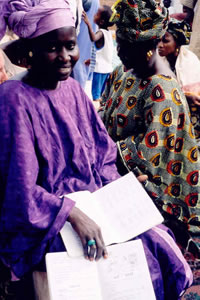
Literacy, language use, and access to education significantly impact the lives of the Senegalese women. (Fatou Sow, June 26, 2003 , personal communication). There is a 67% illiteracy for French and national languages among women, largely due to the history of non-compulsory education. When individuals did go to school it was primarily the male children. The female children were at home helping their mothers.
In 1992, the government created a ministry of adult education and literacy teaching with the goals of decreasing the disparities of gender and geography (i.e., rural vs. city) in literacy. Although the World Bank gave money for these national language literacy projects (13 million), due to structural adjustment, the World Bank has demanded that cuts be made in the formal schooling system for children.
This woman in Thies is proudly shows the texts that she is learning to read.
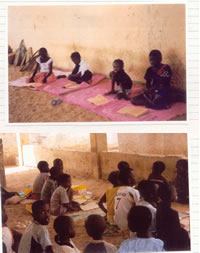
These children are part of a daara, a Qu'ranic school located in their village. There, these children learn to read and write the Qu'ranic text. As we walked by the daara, the young boys and girls were singing - I suspect, the words that they were reading in the Qu'ran.
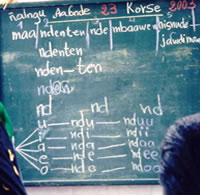
Many of the national language literacy projects used a whole language approach to reading. The teacher/facilitator would engage the class in a discussion about a familiar topic, i.e., malaria, commerce. Then the facilitator would use a sentence that emerged from the discussion as an example for reading, sound letter recognition, understanding syllables, and vocabulary. For example, during a discussion of malaria, one woman stated that you get malaria from mosquitoes.
" Malaria comes from mosquitoes " was written on the board. Then the facilitator helped the class (1) identify separate words in the sentence, (2) counted the words, (3) selected one word (e.g., malaria), and then (4) counted the syllables in that word, (5) identified the structure of each syllable (morphology), (6) made other syllables with the first sound (i.e., m) and other vowels.
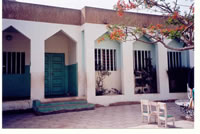
This is the Mariama Niasse Daara (Islamic School), which has students ranging from preprimary grades through secondary grades. The medium of instruction is Wolof (for preprimary grades), Arabic, French, and English. Children learn and use all of these languages. Although the secular curriculum of the schools is used in this particular daara, students also receive religious instruction.
The founder of this school, Miriama Niasse is the grand daughter of a holy man who fought in the religious wars during the 19 th century. She was a pioneer in women's education, as she was one of the first women in the leadership of the brotherhoods (i.e., religious community).

Ten to 15 years ago, there were Senegalese migrants killed in Mauritania and Mauritanian migrants killed in Senegal as retaliation. Healing the wounds and suspicions has taken a long time, but now the Senegalese and Mauritanian children go to school together in harmony.
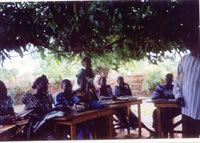
Women's Literacy group in the village of Samba Kuta . Here the women are participating in a math lesson using, what I would call a whole language approach.
Specifically, the teacher engaged the women in a conversation about their trade (e.g., selling fruit, or materials), and then they learned how to complete an expense record using their own business as an example.
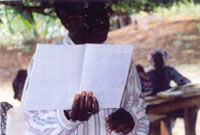
After becoming literate in their national language, the women of Samba Kuta wrote the history of their village. Pictured here is Lamine Kane, our cultural guide, holding up the history book of the village.

One of the consequences of globalization is increased migration. High school students are being prepared to go abroad by studying various languages.

The de jure language policy in Senegal is that French is the official language; however, everywhere we went we realized that the de facto language policy is different. All languages, national languages (Wolof, Sér è r, Pulaar [Fulani/Fulbe], Soninké, Mandinké, and Diolla [Jollah]), Arabic, French, Italian, Spanish, English, and others were spoken. These various languages were even represented in the graveyard.
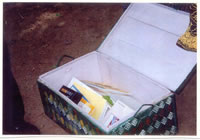
The village of Samba Kuta established its own library.
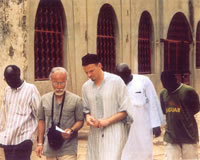
During the 15th century, the arrival of the Europeans in Senegal inserted extreme violence into the existence of the Senegalese populace. Islam was used then in response to slavery and oppression. Four Muslim Brotherhoods exist in Senegal . All founders of the brotherhoods were boran in the 1850s - they were teenagers when colonialism was at its highest - they lived in violence. They did not fight oppression with weapons so they created an alternative for resistance.
- Q'adiriya started in Iraq . It is the oldest and the smallest brotherhood (Founder was Abdul Qadir Jelani).
- Lahiniyya was initiated by Limdimon Thiow (he changed his last name from Laye) who was a fisherman in S enegal , and is the newest brotherhood.
- Amadou Bamba, from Senegal, initiated the Muridiyya. Their capital is in Touba.
- Tidjaniyya is from Morocco and was initiated by Cheikh Amhad al Tijdjanni, but brought to West Africa by El Hadj Oumar Tall. This brotherhood has an emphasis on literacy and education. This picture shows Lamine Kane (from Senegal ), Santiago (project director), and three brothers from the Tidjaniyya Brotherhood In Kaolack , Senegal , walking on the road between the school and hospital run by this brotherhood.
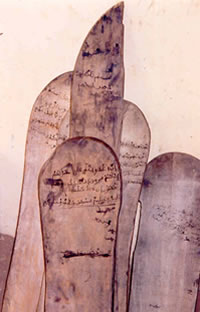 What does it mean to be literate? If a person is able to read and write a language for religious purposes, is he or she literate? In Senegal , some very young children are first exposed to writing by learning to read and write religious text on Q'uranic writing boards. Bamboo sticks are carved into writing implements, and the wooden boards are used as the canvass from early writing.
What does it mean to be literate? If a person is able to read and write a language for religious purposes, is he or she literate? In Senegal , some very young children are first exposed to writing by learning to read and write religious text on Q'uranic writing boards. Bamboo sticks are carved into writing implements, and the wooden boards are used as the canvass from early writing.